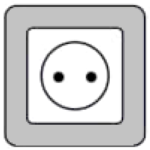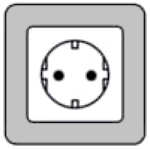Plug For Belarus: What You Need To Know
What is the plug for Belarus? Before you travel, check the information below to make sure your electronic devices are compatible with the outlet type and voltage.
Electrical Summary
Plug Compatibility: Type C, Type F
Voltage: 220V – 240V
Frequency: 50 Hz
Type C

Type F

Can North Americans use Electronics in Belarus without an Adapter?
No! North Americans will need an adapter for the outlets and a transformer for the voltage when traveling to Belarus. North Americans device plugs will not work with the outlet types in Belarus. Also, the voltage in Belarus is different from North American voltages.
Can Europeans use Electronics in Belarus without an adapter?
Yes! Europeans do not need a travel adapter or transformer when traveling to Belarus. Most device plugs will work with the outlet types in Belarus. Also, the voltage in Belarus is the same as in Europe.
What Outlet does Belarus Use?
Type C

Type C plug sockets are used in Europe, Africa and Asia. They have two round pins and no grounding pin. These plugs are typically used with devices that have a voltage of 220-240V. This outlet is rated for 2.5 amps. Plug Type E, and Type F are compatible with this socket. All other plug types will need an adapter.
Type F

Type F electrical plug sockets are used in Germany, Spain, Italy and some parts of Africa. They have two round pins and a grounding pin. These outlets are typically used with devices that have a voltage of 220-240V. This outlet is rated for 16 amps. Plug Type C and Type E are compatible with this socket. All other plug types will need an adapter.
Is it safe to drink water in Belarus?
The safety of drinking water in Belarus is generally good, as the country has a well-developed water treatment system that meets European Union standards. According to the World Health Organization (WHO), more than 99% of the population in Belarus has access to improved drinking water sources, which means that the water is from a protected well or spring, or treated through a piped system.
However, it is still recommended to take precautions and avoid drinking water from unknown sources or sources that may be contaminated. For example, if you are traveling in rural areas, it is advisable to boil tap water before drinking it or to use a water filter.
Bottled water is widely available in Belarus and is a safe option for drinking. It is essential to ensure that the seal is intact before consuming the bottled water.
If you are traveling to Belarus, it is recommended to consult with a healthcare provider or a travel health specialist for specific recommendations on how to stay healthy and avoid waterborne diseases. However, in general, tap water in Belarus is safe to drink, and there is no need to take extra precautions.
We recommend always packing a filtered water bottle when traveling:
Travel Essentials
Be sure to check our list of travel essentials before your trip!
Should I get travel insurance when traveling to Belarus?
It is generally recommended to get travel insurance when traveling to a different country. Travel insurance can provide financial protection and peace of mind in case of unexpected events, such as medical emergencies, trip cancellations, lost or stolen baggage, or other travel-related mishaps.
Travel insurance can cover various expenses related to your trip, such as medical expenses, emergency medical transportation, trip cancellation or interruption, lost or stolen baggage or personal belongings, and other travel-related expenses.
Before purchasing travel insurance, it’s important to carefully review the policy details, including the coverage limits, exclusions, and any applicable deductibles or copays. You should also make sure that the policy covers any activities or destinations that you plan to participate in or visit during your trip.
Travel Summary
The capital city of Minsk is a must-see destination, with a mix of Soviet-era monuments and modern buildings, including the impressive National Library of Belarus. Visitors can also explore the city’s museums, including the Belarusian National Arts Museum and the Museum of the Great Patriotic War.
Belarus is also known for its picturesque countryside, with national parks, forests, and lakes offering opportunities for hiking, camping, and wildlife watching. The Belovezhskaya Pushcha National Park is a UNESCO World Heritage site and one of the last remaining primeval forests in Europe, home to the European bison and other rare species.
The country is also rich in history, with many castles, palaces, and museums showcasing Belarus’s past. Some of the most popular sites include the Mir Castle Complex, a UNESCO World Heritage site known for its Gothic and Renaissance architecture, and the Nesvizh Castle, a stunning palace surrounded by beautiful gardens.
Belarus is a welcoming destination for travelers, with a strong focus on tourism. The country’s official language is Belarusian, but many people speak Russian and English as well. The cuisine is also a highlight, with traditional dishes like draniki (potato pancakes) and machanka (pork stew) reflecting the country’s Slavic roots.
Overall, Belarus offers a unique travel experience for those looking to explore Eastern Europe’s history, culture, and natural beauty. With its friendly locals, diverse attractions, and rich heritage, Belarus is well worth a visit.
Traveling to another country? Check out our Countries page for more info.